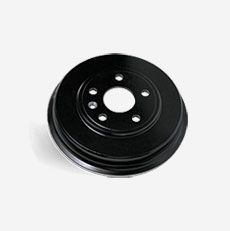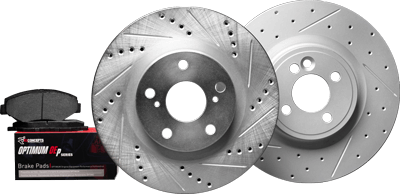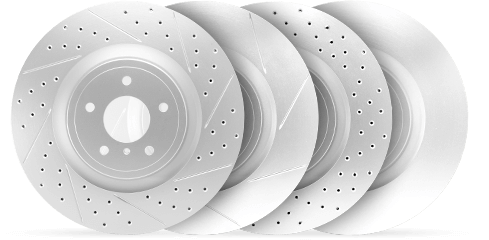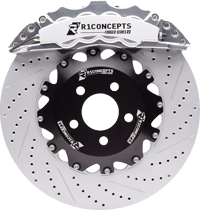Every time you press your brake pedal, drum brakes are responsible for bringing your vehicle to a halt. But how do drum brakes work? Read more to know about the mechanics of drum brakes.
Key Takeaways
- Drum brakes function through a systematic process beginning with the conversion of mechanical force from the brake pedal to hydraulic pressure, which then moves through the brake lines to the wheel cylinders, activating the brake shoes.
- Key components of drum brakes include the brake drum, brake shoes with friction lining, wheel cylinder, springs, adjuster, and parking brake lever, each contributing to the effectiveness and reliability of the braking system.
- Self-adjusting drum brakes enhance efficiency by maintaining optimal distance between the brake shoes and drum, reducing maintenance needs and improving safety, while manual adjustments are minimized after the initial setup.
Drum Brake Mechanics
The complexity of drum brakes involves a harmonious interplay of parts that collaborate to maintain the safety of your vehicle. This sequence begins with engaging the brake pedal and culminates in bringing your car to a halt
When you step on the brake pedal, it causes a chain reaction that begins with a surge of fluid from the master cylinder. This wave of pressure races to the wheel cylinders at each tire and it forces the pistons to press the brake shoes against the brake drum, creating friction that slows the wheel. When you let go of the pedal, springs pull the brake shoes back, allowing the wheel to turn freely again.
Drum Brake Components: A Closer Look
Understanding the complexities of drum brakes requires familiarity with their various parts. We’ll delve into the critical elements that comprise the drum brake system, venturing beneath the hood and to the area behind each wheel.
Brake Drum
The brake drum serves as the critical location for braking action, encompassing a round casing that spins in unison with the wheel and houses key elements of the drum brake system. Consider it similar to a stage where various components such as brake shoes, springs, and wheel cylinders perform their specific functions to halt the vehicle.
Designed robustly to endure substantial heat and force, the brake drum is crafted to rotate in harmony with the wheels of your car. This harmonization guarantees that whenever friction is generated by contact from the brake shoes, it aligns precisely with every turn of your wheels. It’s crucial for achieving peak efficiency within any braking system that there be regular upkeep on both brake drums and shoes.
Brake Shoes and Friction Lining
During the deceleration of a vehicle, brake shoes and brake pads are integral elements. They possess a unique friction lining that is essential in producing the resistance needed to reduce speed. The expansion of brake shoes against a spinning drum is instigated by hydraulic pressure, which generates friction.
This process where friction plays such an important role cannot be overstated because it allows for the transformation of kinetic energy into thermal energy. This remarkable conversion exemplifies physics applied practically and ultimately serves to bring your vehicle to a halt.
Wheel Cylinder
Within the brake system, the role of the wheel cylinder is crucial as it converts hydraulic pressure into a mechanical force. It contains vital components such as pistons, seals, and a spring, which are essential for its function to apply force to the brake shoes.
As brake fluid-generated hydraulic pressure is delivered to the wheel cylinder, this activates its pistons. These pistons subsequently extend outward pressing against the rotating drum via the brake shoes, thereby initiating friction that effectively decelerates or stops movement of the vehicle’s wheel.
Springs, Adjuster, and Parking Brake Lever
Comparable to the detailed workings of a timepiece, the drum brake system’s functionality—particularly within the rear brakes—involves various smaller components that are critical yet may be underestimated. One such component is the return springs. These springs retract the brake shoes from their contact with the drum when pressure on the brake pedal ceases, thus permitting free wheel movement.
Meanwhile, an adjuster maintains an appropriate distance between the friction material of the brake shoes and drum to counterbalance wear. There exists a parking brake lever—an alternative manual method used to apply force onto your vehicle’s brakes firmly holding it stationary when parked. Integral in this mechanism is also performance by which safety while immobilized can depend significantly upon its effective operation.
Self-Adjusting Drum Brakes: An Advanced Feature
Technological advancements have led to the enhancement and user-friendliness of drum brakes. Among these developments, a notable one is the self-adjusting drum brake, which merits exploration for its role in optimizing the braking experience.
Benefits of Self-Adjusting Drum Brakes
Self-adjusting drum brakes act as an internal mechanic for your braking system, automatically regulating the space between the brake shoes and the drum. This function compensates for any wear that occurs, guaranteeing steady performance of your brakes.
The advantages provided by these brakes encompass:
- Diminished time spent on maintenance
- Enhanced safety through constant availability of maximum braking force
- Preservation of a uniform feel when you press the brake pedal
- Prolonged durability of components within the brake system
These innovations serve as a testament to how advancements in technology can elevate both convenience and safety in driving experiences.
How Self-Adjusting Drum Brakes Work
The hidden workings behind the effectiveness of self-adjusting drum brakes can be attributed to their adjuster mechanism. This clever component springs into action when the car comes to a halt while reversing, detecting any excessive space between the brake shoe and drum. When needed, it automatically tightens this gap ensuring that the shoes remain in close proximity with the drum for optimal braking efficacy.
After an initial manual calibration, these smart brakes Require no Hands-on adjustments. It’s as though there’s a dedicated mechanic tirelessly working behind the scenes to perpetually optimize your braking system’s function—securing consistently peak performance from your vehicle’s brakes throughout its service life.
Drum Brakes Pros and Cons

Drum brakes, much like any other technology, possess both merits and demerits. Their dependable nature and consistent performance have made them a trusted choice over many years. They are not without their shortcomings.
To form an objective perspective on drum brakes, it is important to evaluate both their positive attributes and the constraints they present.
Advantages of Drum Brakes
Numerous benefits come with drum brakes. They stand out as a budget-friendly option, providing both manufacturers and vehicle owners considerable savings. Thanks to their sealed construction, they are less prone to rust, which means maintenance is infrequent and their longevity is extended.
When comparing disc and drum brakes for effectiveness in applying braking force, drums have an edge due to the more expansive area of friction contact they offer relative to discs of similar dimensions. This self-energizing feature minimizes the requirement for intense forces such as hydraulic pressure within your car’s brake system – enhancing its overall efficiency.
Disadvantages of Drum Brakes
While drum brakes offer a range of advantages, they also present certain disadvantages such as:
- Difficulty in effectively dissipating heat, potentially affecting performance
- A tendency to overheat with intense braking demands, for example when going downhill or stopping repeatedly at high speeds
- The possibility that overheating may reduce the effectiveness of the brakes
Brake fade can manifest within drum brakes due to excess heat, causing them to lose efficiency. If water becomes entrapped inside the drums, it could interfere with the necessary friction for effective braking. Therefore, these potential issues should be carefully weighed when selecting a braking system.
Summary
The drum brake system is an intricate fusion of hydraulic and mechanical technologies that work together to accelerate your vehicle with precision. Every part, from the moment you engage the brake pedal until your vehicle comes to a complete stop, plays an essential role in maintaining road safety through effective braking force.
While they may have some limitations, the benefits of drum brakes make them a steadfast option for many types of vehicles. With their economical nature, robust braking force capabilities, and inherent self-adjustment properties, these brakes repeatedly demonstrate their efficacy. As advancements in automotive technology surge forward, it’s exciting to think about what new developments may emerge within the realm of drum brakes. Undoubtedly though, as we look ahead into future enhancements in automobile safety features—drum brake systems are sure to remain indispensable components within our vehicular landscapes.
Frequently Asked Questions
How do car brakes work?
Upon pressing the brake pedal, the hydraulic system is triggered to propel brake fluid towards the caliper. This action forces the brake pads against the rotor with enough friction to accelerate your vehicle.
Are drum brakes better than disc brakes?
Due to their expansive friction contact area, drum brakes typically outlast disc brakes in durability, resulting in less frequent need for lining replacements and thus extending their lifespan.
Do drum brakes need brake fluid?
Indeed, for drum brakes to function properly, they require brake fluid. This fluid acts by propelling two pistons located inside the wheel cylinder, which in turn apply pressure to the brake shoes so that they make contact with the interior surface of the brake drum and engage the brakes on that particular wheel.
What are the advantages of drum brakes?
Drum brakes possess benefits including the capacity to deliver a greater braking force and an extended lifespan owing to their broader friction contact surface when compared with disc brakes. They have lower manufacturing costs and produce less heat during operation.
Why did car makes stop using drum brakes?
Due to the problem of heat generation causing the drum to expand away from the pads when it becomes hot, unlike disc brakes where expansion moves towards the pads, drum brakes have been gradually discontinued.
Do drum brakes have rotors?
No, drum brakes do not have rotors. Instead, they utilize a brake drum, which is a cylindrical component that encases the internal parts of the drum brake system. The brake drum works along with the brake shoes, wheel cylinder, and additional elements to generate the necessary friction for halting the vehicle. The brake rotor, on the other hand, is a flat, disc-shaped component used in disc brake systems, where brake pads clamp onto the rotor to achieve braking. Thus, the brake drum and brake rotor are different types of components, each specific to their respective braking systems.










